Africa Through The Lens
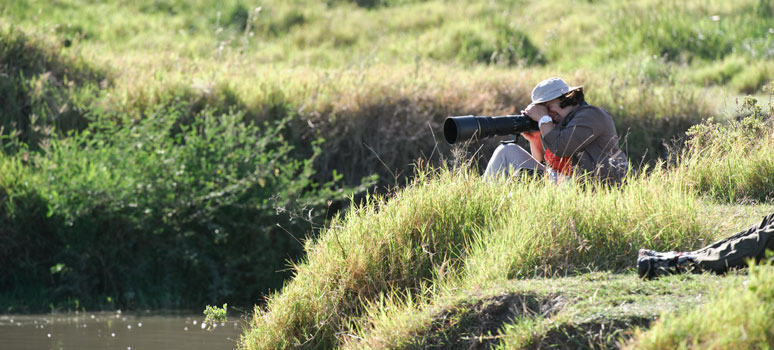
Serengeti is what the Maasai people called the area when they arrived in what's now the northern part of Tanzania. It's easy to see why they chose this name, which translates to "Endless Plains". As far as the eye can see, grassy plains dominate this landscape. Millions of Zebras, Wildebeests, Cape Buffalos and other animals roam these plains in search of water and food in a timeless circle called the Great Migration. Wherever the herds go, the predators follow. Lions, Cheetahs, Leopards, Hyenas and other scavengers prey on the weak, old, and unlucky. When food and water are plenty for a while, a flood of new life takes its first shaky steps in a ruthless world. Many of the newborns are killed by predators, but by timing their births in a short period of time the herds overpower the ability of the hunters. And the circle starts over.
We have wanted to witness this incredible eco system for a long time. In 2009, while on a trip with our good friend Eric Cheng, he recommended we go with wildlife photographer Andy Biggs. During our earlier research for ways to visit Tanzania, we had already decided we wanted to travel with Thomson Safaris, so when we realized Andy and Thomson offered photography trips to the Serengeti, the decision was easy. In february 2011 we would join Andy for his trip aptly named "Africa, Through the Lens".
For the last decade Julie and I have done many underwater shoots. We have become comfortable in that environment and although we're far from pros, we are always very pleased with our results. From the watery depths of Papua New Guinea or Komodo, to the dusty plains of Africa is quite a big step and we felt a little nervous about this new adventure. In the months leading up to this trip we had many questions for Andy, and like a patient tutor he answered everything. By the time we were about to to embark on this journey we were ready for the things to come. We were bringing a Nikon D3s, three Nikon D7000s, a 200-400mm, 500mm, 70-200mm, 18-200mm and 17-35mm lenses. This is our day to day diary of this trip.
Day 1.  I've always wondered what people mean when they say "dry heat". Usually we visit places that are 30C and 100% humidity. Not so in Africa. It was a balmy 25C and a wonderful breeze made everything lovely. After arriving in Tanzania, a private plane brought us to the center of the Serengeti and the moment we landed we knew we were in a different world. Grassy plains with trees dotted the landscape and zebras grazed in the distance. The trip had not even begun, but we were already excited. Parked near the gravelly airstrip were our 5 landrover defenders, our home for 12 hours a day for the rest of the trip. They brought us to our camp, a beautiful set of luxury tents on the side of a hill overlooking a foresty area. As we drove on the final stretch towards the camp, giraffes were crossing the dirt road. How amazing was this going to be, giraffes right near our camp.
I've always wondered what people mean when they say "dry heat". Usually we visit places that are 30C and 100% humidity. Not so in Africa. It was a balmy 25C and a wonderful breeze made everything lovely. After arriving in Tanzania, a private plane brought us to the center of the Serengeti and the moment we landed we knew we were in a different world. Grassy plains with trees dotted the landscape and zebras grazed in the distance. The trip had not even begun, but we were already excited. Parked near the gravelly airstrip were our 5 landrover defenders, our home for 12 hours a day for the rest of the trip. They brought us to our camp, a beautiful set of luxury tents on the side of a hill overlooking a foresty area. As we drove on the final stretch towards the camp, giraffes were crossing the dirt road. How amazing was this going to be, giraffes right near our camp.
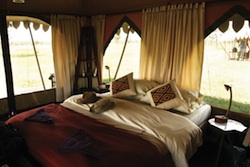 The camp needs a bit of explanation in itself. Thomson Safaris is one of only a few outfits that are allowed to have facilities right in the middle of the action. They have a tented camp right in the Serengeti, no fences, no barriers, just you and the animals sharing the same space. During the day we would often see animals in the vicinity of the camp, from zebras to giraffes, from warthogs to gazelles. At night, it was not unheard of for these animals to actually venture into the camp. Right outside the tent you would hear warthogs dig around, and if you'd shine your light into the edges of the camp, shiny eyes greeted you. And while you're trying to sleep, zebras would call for alarm, while hyenas grew more and more excited. It is a feeling that's difficult to describe. The tents are also quite luxurious as far as camping goes. They have large beds with mattrasses, a vanity area with sinks and mirrors, a bathroom and a shower. Hot water is provided on request, usually right before taking a shower. It's not a fancy lodge, but it's very comfortable and the experience is worth it. Being right where the animals are beats anything else there is.
The camp needs a bit of explanation in itself. Thomson Safaris is one of only a few outfits that are allowed to have facilities right in the middle of the action. They have a tented camp right in the Serengeti, no fences, no barriers, just you and the animals sharing the same space. During the day we would often see animals in the vicinity of the camp, from zebras to giraffes, from warthogs to gazelles. At night, it was not unheard of for these animals to actually venture into the camp. Right outside the tent you would hear warthogs dig around, and if you'd shine your light into the edges of the camp, shiny eyes greeted you. And while you're trying to sleep, zebras would call for alarm, while hyenas grew more and more excited. It is a feeling that's difficult to describe. The tents are also quite luxurious as far as camping goes. They have large beds with mattrasses, a vanity area with sinks and mirrors, a bathroom and a shower. Hot water is provided on request, usually right before taking a shower. It's not a fancy lodge, but it's very comfortable and the experience is worth it. Being right where the animals are beats anything else there is.
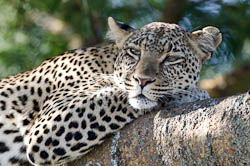 In the afternoon of the first day we did our first game drive in the Makoma Hills. 13 people rode in 5 vehicles, which is very spacious. Other operators may cram 8 people into 1 vehicle, we had 2 or 3 people per vehicle which gave everyone ample room for all the photography gear. Never during the whole trip did I feel space-restricted in any way. We each had two bodies set up ready to go, one with a large telezoom, and one with a smaller zoom for closer encounters. Everything right next to us, only an arms length away. It couldn't be easier. We spotted many lions and other animals that afternoon, but the real treat came towards the end of the drive. Right near the road a leopard had taken up residency on the lowest branch of a tree. In easy reach of our long telezooms. We were told this is a rare occurance, and we felt really lucky to be so close to one of Africas most elusive and majestic predators. As if all that wasn't enough, we also spotted two cheetahs on a mound. That night we went to bed tired but elated.
In the afternoon of the first day we did our first game drive in the Makoma Hills. 13 people rode in 5 vehicles, which is very spacious. Other operators may cram 8 people into 1 vehicle, we had 2 or 3 people per vehicle which gave everyone ample room for all the photography gear. Never during the whole trip did I feel space-restricted in any way. We each had two bodies set up ready to go, one with a large telezoom, and one with a smaller zoom for closer encounters. Everything right next to us, only an arms length away. It couldn't be easier. We spotted many lions and other animals that afternoon, but the real treat came towards the end of the drive. Right near the road a leopard had taken up residency on the lowest branch of a tree. In easy reach of our long telezooms. We were told this is a rare occurance, and we felt really lucky to be so close to one of Africas most elusive and majestic predators. As if all that wasn't enough, we also spotted two cheetahs on a mound. That night we went to bed tired but elated.
Day 2. 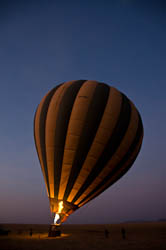 The next morning we woke up at 5:30am. We're not morning people, but here there's no other option. Early morning is the best time to be out there. Before sunrise you have to be out and ready to photograph whatever comes in front of your lens. The very first thing that blew me away was the incredible sunrise over the Serengeti. There was no time to waste, today was a very special occasion. We were going on a hot air balloon ride. This is not as easy as it sounds, because Julie is afraid of heights, but she was going to give it her best shot to experience this once in a life time opportunity. The enter procedure of the balloon was a little complicated. They started with the balloon on its side, and all the passengers had to be on their backs in the open cabin. Then as the hot air is blown inside the balloon with a giant flame blower, the cabin slowly rights itself and takes off. I could see that Julia was very nervous, and as soon as the balloon was airborn she sat down on the bottom.
The next morning we woke up at 5:30am. We're not morning people, but here there's no other option. Early morning is the best time to be out there. Before sunrise you have to be out and ready to photograph whatever comes in front of your lens. The very first thing that blew me away was the incredible sunrise over the Serengeti. There was no time to waste, today was a very special occasion. We were going on a hot air balloon ride. This is not as easy as it sounds, because Julie is afraid of heights, but she was going to give it her best shot to experience this once in a life time opportunity. The enter procedure of the balloon was a little complicated. They started with the balloon on its side, and all the passengers had to be on their backs in the open cabin. Then as the hot air is blown inside the balloon with a giant flame blower, the cabin slowly rights itself and takes off. I could see that Julia was very nervous, and as soon as the balloon was airborn she sat down on the bottom. 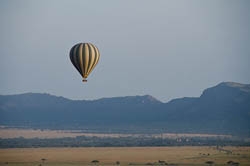 But after only a few minutes she stood up, and before long she was enjoying the view with the rest of us. And what a view it was. All around us the Serengeti stretched as far as the eye could see, with an early morning mist giving everything an eerie but beautiful touch. Hippos were enjoying their mudbaths and gazelles were darting around. Towards the end Julie was even taking photographs. I was very proud of her. Fear of heights is not an easy thing to conquer, but she did it.
But after only a few minutes she stood up, and before long she was enjoying the view with the rest of us. And what a view it was. All around us the Serengeti stretched as far as the eye could see, with an early morning mist giving everything an eerie but beautiful touch. Hippos were enjoying their mudbaths and gazelles were darting around. Towards the end Julie was even taking photographs. I was very proud of her. Fear of heights is not an easy thing to conquer, but she did it.
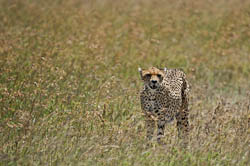 After the balloon ride, which ended with a perfect landing right on a road, we had a nice breakfast out on the plains. Monkeys were darting around, but we were all still taking in the experience of earlier that morning. After breakfast we joined the few people that didn't go on the balloon ride, and headed towards an area called the Masai Kopjes. This is an area in the plains where rocky outcrops named Kopjes dot the landscape. You drive from one Kopje to another, checking them for lions and other animals. In the early afternoon we found a nice tree and had lunch in its shade. There is nothing more rewarding than a nice lunch while your eyes lazily gaze over the endless plains. From a distance we could see a herd of elephants, and after lunch we headed closer to them. Our first encounter with this enourmous animal. Unfortunately the elephants kept their distance, but we soon found a closer subject. A lone cheetah walked straight for our cars and ended up walking just a few feet away from our car. Wow.
After the balloon ride, which ended with a perfect landing right on a road, we had a nice breakfast out on the plains. Monkeys were darting around, but we were all still taking in the experience of earlier that morning. After breakfast we joined the few people that didn't go on the balloon ride, and headed towards an area called the Masai Kopjes. This is an area in the plains where rocky outcrops named Kopjes dot the landscape. You drive from one Kopje to another, checking them for lions and other animals. In the early afternoon we found a nice tree and had lunch in its shade. There is nothing more rewarding than a nice lunch while your eyes lazily gaze over the endless plains. From a distance we could see a herd of elephants, and after lunch we headed closer to them. Our first encounter with this enourmous animal. Unfortunately the elephants kept their distance, but we soon found a closer subject. A lone cheetah walked straight for our cars and ended up walking just a few feet away from our car. Wow.
Day 3. 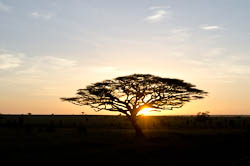 By the third day we were starting to get used to the schedule. Waking up early became easier and everyone was ready to roll before 6 am. This morning we just had to capture the sunrise, so we found an Acacia (Umbrella) tree and watched the sun rise behind it. Nothing says Serengeti like the Acacia tree. Today we were heading to the Gol and Moru Kopjes, in the area beyond the Naabi gate. I really enjoyed this landscape of grassy plains, mixed with denser woodlands.
By the third day we were starting to get used to the schedule. Waking up early became easier and everyone was ready to roll before 6 am. This morning we just had to capture the sunrise, so we found an Acacia (Umbrella) tree and watched the sun rise behind it. Nothing says Serengeti like the Acacia tree. Today we were heading to the Gol and Moru Kopjes, in the area beyond the Naabi gate. I really enjoyed this landscape of grassy plains, mixed with denser woodlands. 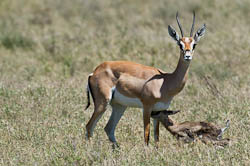 The highlight of the day for us was watching a newborn grant's gazelle take its first steps. I couldn't help but watch around for predators, rooting for the little helpless gazelle to make it beyond this early vulnerable stage. We watched for almost an hour as it stood and fell, slowly finding its footing, while the mother was licking it dry. They weren't all so lucky. Not soon after we encountered two jackals eating a newborn gazelle. We don't know if it was stillborn, or if they killed it, but it was a rude awakening to the cruel reality of life and death in the Serengeti.
The highlight of the day for us was watching a newborn grant's gazelle take its first steps. I couldn't help but watch around for predators, rooting for the little helpless gazelle to make it beyond this early vulnerable stage. We watched for almost an hour as it stood and fell, slowly finding its footing, while the mother was licking it dry. They weren't all so lucky. Not soon after we encountered two jackals eating a newborn gazelle. We don't know if it was stillborn, or if they killed it, but it was a rude awakening to the cruel reality of life and death in the Serengeti.
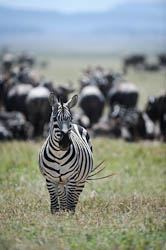 Later that day we came upon a large gathering of zebras and wildebeest. It was the first glimpse into what is the Great Migration. A massive trek of millions of animals between the northern hills and the southern plains of the Serengeti following the rains. We love horses, so watching the zebras interact with eachother was a joy of recognition. Everything we see happen between horses, happens between zebras. From dominant females being shown respect, to male juveniles playing, to large stallions fighting. And in between the busy lines of animals, many zebra foals were seeking the protection and shade of their mothers. We could have watched this for hours and hours.
Later that day we came upon a large gathering of zebras and wildebeest. It was the first glimpse into what is the Great Migration. A massive trek of millions of animals between the northern hills and the southern plains of the Serengeti following the rains. We love horses, so watching the zebras interact with eachother was a joy of recognition. Everything we see happen between horses, happens between zebras. From dominant females being shown respect, to male juveniles playing, to large stallions fighting. And in between the busy lines of animals, many zebra foals were seeking the protection and shade of their mothers. We could have watched this for hours and hours.
The rest of the afternoon was kind of quiet. We didn't find much game, except for another witness to the circle of life. A dead zebra was being surrounded by dozens of vultures. Unfortunately there was no "ripping" vulture, which is the only one that can open a carcass. So the group of vultures were fighting with each other for position around the corpse, without actually being able to eat from it yet except for some small parts like the eyes. It was fascinating to watch.
Day 4. 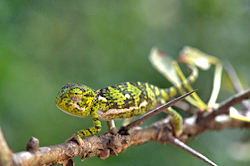 The first half of this day was taken up by the long drive to our next accomodation, the Ndutu Safari Lodge. The drive was nice, but relatively uneventful. The lodge was our only permanent accomodation of the trip. They're nice rooms, but everyone agreed the Thomson tent camps are actually nicer. Even the food was nicer at the tent camps. I don't know how the cooks in the tents do it, but it's amazing that they could out-cook the permanent accomodations of a lodge. As we were getting ready for our afternoon drive, Julie did the impossible by noticing a tiny chameleon from 6 feet away. She tends to do this during our dive trips, but I was amazed she could even find critters on bushes in Africa! We borrowed a macro lens from Marg, a fellow traveler, and took some quick shots.
The first half of this day was taken up by the long drive to our next accomodation, the Ndutu Safari Lodge. The drive was nice, but relatively uneventful. The lodge was our only permanent accomodation of the trip. They're nice rooms, but everyone agreed the Thomson tent camps are actually nicer. Even the food was nicer at the tent camps. I don't know how the cooks in the tents do it, but it's amazing that they could out-cook the permanent accomodations of a lodge. As we were getting ready for our afternoon drive, Julie did the impossible by noticing a tiny chameleon from 6 feet away. She tends to do this during our dive trips, but I was amazed she could even find critters on bushes in Africa! We borrowed a macro lens from Marg, a fellow traveler, and took some quick shots.
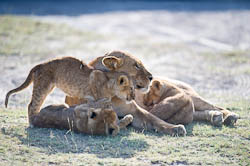 The late afternoon game drive led us through a swampy area which reminded me of a river delta. I really enjoyed the scenery of this area, with a varied amount of wildlife in a denser area than the earlier plains. We quickly came upon one of the highlights of the trip, a pride of lions with three cubs. At first they were all sleeping, but the cubs woke up and decided it was time to feed. They all found a spot to drink from their mother, in one of the most endearing moments I've ever seen. After they were full, it was playtime. They went from adult to adult to see who would be the most annoyed by them. The prize went to a large male who growled loudly as the cubs started to swat at his tail. We laughed and watch this show for hours, until the sun was setting and the cars had to make a mad dash back to the lodge to make it back before the strictly enforced dusk time limit.
The late afternoon game drive led us through a swampy area which reminded me of a river delta. I really enjoyed the scenery of this area, with a varied amount of wildlife in a denser area than the earlier plains. We quickly came upon one of the highlights of the trip, a pride of lions with three cubs. At first they were all sleeping, but the cubs woke up and decided it was time to feed. They all found a spot to drink from their mother, in one of the most endearing moments I've ever seen. After they were full, it was playtime. They went from adult to adult to see who would be the most annoyed by them. The prize went to a large male who growled loudly as the cubs started to swat at his tail. We laughed and watch this show for hours, until the sun was setting and the cars had to make a mad dash back to the lodge to make it back before the strictly enforced dusk time limit.
Day 5.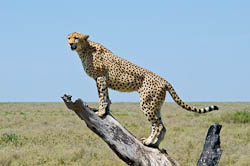 During the morning drive we found out what it means to be in a smaller area with many lodges. Every time a main subject (mostly big cats) was found, the area was quickly swamped by cars from all the lodges. We got our first hint of this the day before with the cubs, but today showed us this is the norm. I was secretly longing for the plains of the previous days. This didn't keep us from having one of the best encounters of the trip though. Three male cheetahs were actively walking around the grasslands around the swamps. We watched for hours, until finally they gave us a great show as one of them climbed a dead tree to survey the surrounding. Julie and I happened to end up in the prime spot, and the resulting image is one of the best of the trip.
During the morning drive we found out what it means to be in a smaller area with many lodges. Every time a main subject (mostly big cats) was found, the area was quickly swamped by cars from all the lodges. We got our first hint of this the day before with the cubs, but today showed us this is the norm. I was secretly longing for the plains of the previous days. This didn't keep us from having one of the best encounters of the trip though. Three male cheetahs were actively walking around the grasslands around the swamps. We watched for hours, until finally they gave us a great show as one of them climbed a dead tree to survey the surrounding. Julie and I happened to end up in the prime spot, and the resulting image is one of the best of the trip.
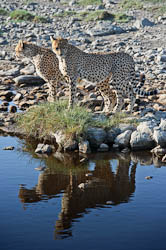 The afternoon brought us to the more open plains south of lake Masek. Even though it wasn't very succesful photographically, it was one of my best personal moments of the trip. Here large herds of wildebeests and zebras were moving around, and we ended up right in the middle of them. As the herds passed us on all sides, it was the first time I really understood what the Great Migration is all about.
The afternoon brought us to the more open plains south of lake Masek. Even though it wasn't very succesful photographically, it was one of my best personal moments of the trip. Here large herds of wildebeests and zebras were moving around, and we ended up right in the middle of them. As the herds passed us on all sides, it was the first time I really understood what the Great Migration is all about.
Day 6. When I didn't think we could get any better cheetah encounters, this morning proved me wrong. We had two male cheetahs walking around a stream. They jumped back and forth over the stream, and at times drank water. What made it especially nice was that the blue sky reflected in the stream, together with the two cheetahs, making for some really amazing compositions. Almost everyone was really excited by this spectacle. Most of the afternoon was spent watching a watering hole full of zebras and wildebeest. The noise was deafening as zebras and wildebeests were darting in and out of the water. I tried out a panorama shot around the watering hole, which surprisingly turned out well, despite all the movement.
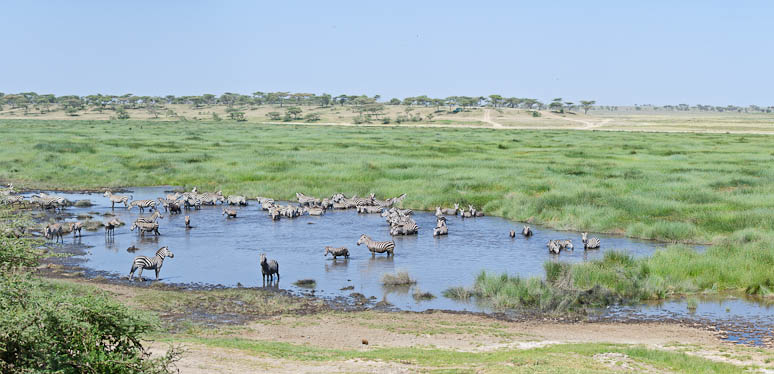
Day 7. 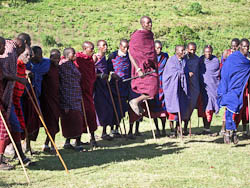 We spent most of the morning moving to our next tented camp on the inner slopes of Ngorogoro Crater. This camp is actually within the gates of the crater, only a few camps are allowed this priviledge. Before we got there, we visited the Oldupai Gorge, an area where researchers have found early homonid fossils in almost all of the earth layers going back millions of years. We arrived at the camp in the early afternoon, and spent our time just relaxing for a couple of hours. A welcome change to the very hectic and busy schedule of the days before. In the late afternoon we visited a Maasai village near our camp. We got a tour of the village, saw the insides of their huts and their school, and some of us joined in for a welcome dance. The last hour was spent checking out the handicrafts the Maasai women make where Julie bought some nice bracelets.
We spent most of the morning moving to our next tented camp on the inner slopes of Ngorogoro Crater. This camp is actually within the gates of the crater, only a few camps are allowed this priviledge. Before we got there, we visited the Oldupai Gorge, an area where researchers have found early homonid fossils in almost all of the earth layers going back millions of years. We arrived at the camp in the early afternoon, and spent our time just relaxing for a couple of hours. A welcome change to the very hectic and busy schedule of the days before. In the late afternoon we visited a Maasai village near our camp. We got a tour of the village, saw the insides of their huts and their school, and some of us joined in for a welcome dance. The last hour was spent checking out the handicrafts the Maasai women make where Julie bought some nice bracelets.
Day 8. Today was the first day driving around the Ngorogoro Crater. Technically it isn't a crater but a caldera. I suppose Ngorogoro Caldera doesn't quite have the same ring to it. The crater formed about two to three million years ago when a large vulcano exploded and collapsed on itself. The base of the crater covers 260 square kilometers, while the rim towers over 600m high around. It is truly one of the most amazing things to see and should be on everyones bucket list. Many of the animals in the crater stay there permanently, unlike those in the Serengeti. This does come with its own set of problems, most pressing that of inbreeding. The lions especially suffer from this serious problem. Another big difference with the Serengeti is that there are no giraffes and impalas.
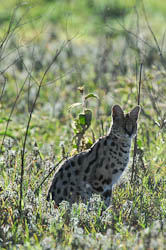 We arrived on the floor of the crater before sunrise. The first thing we encountered was a pride of lions. They were just relaxing in the early morning. That is, until we saw that one of the cubs was seriously injured. It was limping badly and could only walk short distances. The mother lion was keeping a vigilant watch over the cub, as it tried to move away from the vehicles. It was impossible not to feel sorry for the little guy, but our guide insisted that it would almost certainly be fine. On that note we left them behind and moments later came upon an extremely rare sighting of a cerval cat. It is a much smaller cat than the more well known lions, cheetahs and leopards.
We arrived on the floor of the crater before sunrise. The first thing we encountered was a pride of lions. They were just relaxing in the early morning. That is, until we saw that one of the cubs was seriously injured. It was limping badly and could only walk short distances. The mother lion was keeping a vigilant watch over the cub, as it tried to move away from the vehicles. It was impossible not to feel sorry for the little guy, but our guide insisted that it would almost certainly be fine. On that note we left them behind and moments later came upon an extremely rare sighting of a cerval cat. It is a much smaller cat than the more well known lions, cheetahs and leopards. 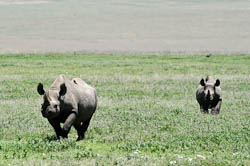 They form their own unique lineage descending from the same ancestor as the lion. They're normally very shy and immediately run away near humans but we were lucky. The cerval cat continued hunting for small prey in the tall grass, showing us his graceful jumping behavior. In the tall grass and early morning light it was hard to get a good photograph, but we were happy just to see it.
They form their own unique lineage descending from the same ancestor as the lion. They're normally very shy and immediately run away near humans but we were lucky. The cerval cat continued hunting for small prey in the tall grass, showing us his graceful jumping behavior. In the tall grass and early morning light it was hard to get a good photograph, but we were happy just to see it.
The crater is also one of the few places where it's a little easier finding rhinos, and later that afternoon we spotted several of them. A mother with its young paraded right in front of our vehicle, giving us an upclose encounter. And if that wasn't enough, we also had our first really close view of an elephant bull.
Day 9. 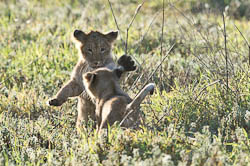 It was very cold this morning as we woke up. The camp is a few thousand feet above sea level, and it can get pretty cold at night.
It was very cold this morning as we woke up. The camp is a few thousand feet above sea level, and it can get pretty cold at night.  Luckily Thomson provides us with hot water bottles in bed at night, which hold most of their warmth all throughout the night. I would have loved to just stay in the cozy bed, but today is the last day and we had to be at the bottom before sunrise. We arrived down in the crater as the sun was peaking over the rim giving everything a golden glow. There we came upon another one of those scenes you'll never forget. Three small cubs of the same pride we saw earlier were playing around, jumping, fumbling, bugging their parents, hunting insects, and being all around mischievious.
Luckily Thomson provides us with hot water bottles in bed at night, which hold most of their warmth all throughout the night. I would have loved to just stay in the cozy bed, but today is the last day and we had to be at the bottom before sunrise. We arrived down in the crater as the sun was peaking over the rim giving everything a golden glow. There we came upon another one of those scenes you'll never forget. Three small cubs of the same pride we saw earlier were playing around, jumping, fumbling, bugging their parents, hunting insects, and being all around mischievious.
Not only were the cubs active, later that afternoon the two male lions were also moving around. We were hoping for a chase and kill, but that never happened. Julie did shoot one of her favorite images of the trip as a male lion walked straight for us. It was one of her last shots of the trip, which really made her day.
It is very difficult to describe in words what we experienced during this trip in Tanzania. From witnessing new life making its first steps into this world, to death that is merciless and sudden. This is true nature, at its best and its worst. It is sad to think that these kinds of habitats are quickly disappearing. But here in Tanzania in the Serengeti and Ngorogoro, it's surviving. As one of our guides told us, you can not visit Africa only once, and truer words were never spoken. Africa is in our hearts now, and we'll certainly be back.
The
|
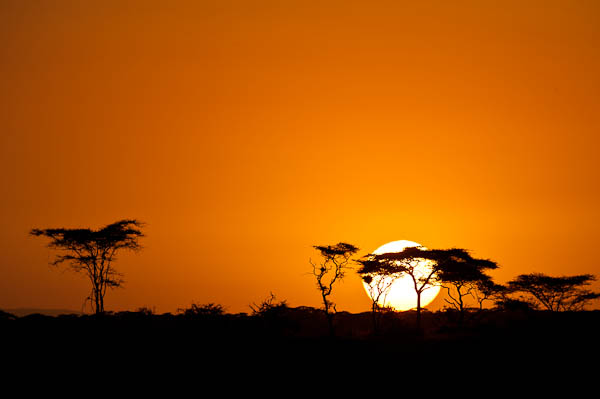
|
End
|